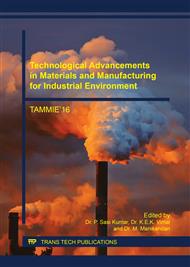p.73
p.81
p.88
p.97
p.105
p.112
p.119
p.127
p.134
Friction Stir Spot Welding of AZ31B Magnesium Alloy
Abstract:
The Electrical Resistance Welding (ERW) of Magnesium and Aluminium is more difficult than steel because the welding machines must provide high currents and exact pressures in order to provide the heat necessary to melt the magnesium for proper fusion at the interface in order to produce a sound weld. Further, resistance welding of magnesium requires a backup plate made of steel to conduct the heat to the workpiece material. To overcome this problem, Friction Stir Spot Welding (FSSW) has been developed. In this study, the hardness distribution and the tensile shear strength of FSSW welds in the AZ31B Magnesium alloy has been investigated and it has been found that tool rotational speed and dwell time plays a major role in determining the weld strength. From the experimental study, a tool rotational speed of 1100 rpm and dwell time of 20 s produced good shear strength of 2824 N and the corresponding grain size was 4.54 μm. This result is very well supported by microstructural examinations and hardness distribution studies.
Info:
Periodical:
Pages:
105-111
Citation:
Online since:
July 2017
Authors:
Keywords:
Price:
Сopyright:
© 2017 Trans Tech Publications Ltd. All Rights Reserved
Share:
Citation:


